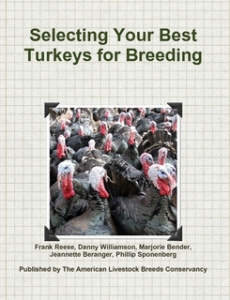
Breed Facts
Status:
Threatened
Use:
Meat
Egg Color:
Pale cream to medium brown with spotting
Egg Size:
Large
Market:
Male Young 17 lbs. Mature – 21 lbs.
Female Young 10 lbs. Mature – 17 lbs.
Temperament:
Variable from docile to aggressive, but generally good natured.
Note:
Be sure to buy your Beltsville Small White turkeys from a reputable source; some breeders sell Midget Whites as Beltsville Small Whites.
BELTSVILLE SMALL WHITE TURKEY
The Beltsville Small White turkey was developed to fill a clearly identified consumer need. In the early 1930s, most turkeys raised in the United States had dark-colored plumage, were medium to large in size, and had a narrow breast without substantial meat. A 1936 survey found that 87% of home consumers wanted a New York-dressed bird (blood and feathers removed) weighing between 8 to 15 pounds. They also wanted a bird that was meaty, well-finished, and free from dark pin feathers. The U.S. Department of Agriculture research center at Beltsville, Maryland then began a seven-year breeding program in 1934 to create a bird that would answer consumer demands: a bird that would fit in apartment-sized refrigerators and small ovens, and feed small families. Researchers developed the new Beltsville Small White variety from a genetic foundation that included the White Holland, White Austrian, Narragansett, Bronze, and Wild Turkey.
The Beltsville came into use in the 1940s and was recognized by the American Poultry Association in 1951. Their popularity peaked in the mid-1950s and, in addition to its use as a purebred, the Beltsville Small White contributed to the development of other strains of medium and small white turkeys. Though, these populations were never very well defined as breeds.
The Beltsville Small White turkey’s success was short-lived and went nearly extinct by the 1970s. While considered a good bird for families, it was less embraced by the hotel and restaurant industry. Processors also preferred larger birds to obtain more “slices.” The Broad Breasted White (or Large White) turkey came to overshadow the Beltsville because, when slaughtered at a young age, the Broad Breasted White fit the processor’s niche for a smaller turkey but had the ability to grow substantially heavier weights for the commercial food trade. By 1965, the new Broad Breasted White had nearly taken over the turkey market. Despite this, the Beltsville Small White still had advantages. Beltsvilles had good reproductive qualities, including the ability to mate naturally, and could be selected, bred, and maintained by small-scale producers. In contrast, Broad Breasted White turkeys generally required artificial insemination for reproduction.
Young Beltsville turkey hens weigh 10 pounds and young toms weigh 17 pounds. The plumage is white, with the head red to bluish-white. The beard is black, the beak is horn colored, and the eyes are dark brown. Shanks and toes are pinkish white.
Today, Beltsville Small Whites are quite rare and kept by few exhibition breeders. A research flock exists at the Iowa State University; however, public access to this flock is almost non-existent. There has been a revival of interest in the variety In recent years though, and efforts are underway to locate and conserve any remnant flocks in the U.S. and Canada.
Did you know:
Only 1,335 domesticated heritage breeding turkeys were found in the U.S. in 1997. Bringing heritage turkeys back from the brink of extinction was one of The Livestock Conservancy’s early conservation successes. We helped increase the population by 750% over ten years thanks to the support of our members. Click here to join today and help save heritage breeds for tomorrow.
You may be interested in…

Breed Facts
Status:
Threatened
Use:
Meat
Egg Color:
Pale cream to medium brown with spotting
Egg Size:
Large
Market Weight:
10 – 17 lbs
Temperament:
Variable from docile to aggressive
You may be interested in…




